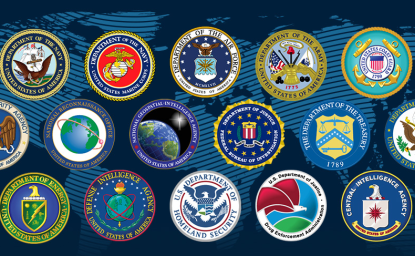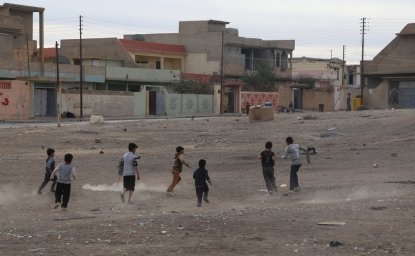Operation Inherent Resolve has quietly but dramatically escalated its operations in Iraq in 2016. Airstrikes by the U.S.-led coalition are up by 65 percent over the same period last year, according to data tallied from Central Command’s daily rundowns.
Targets have included ISIS fighters, tanks, checkpoints, oil fuel trucks, arms depots, cash storage sites and tunnels. So many fighters have died that ISIS recruitment has dropped from 1,500 a month to 200 a month, the Pentagon claimed in April. Meanwhile, the number of American forces on the ground in Iraq increased to some 4,000.
In contrast, the number of airstrikes in Syria in 2016 has actually dropped 5 percent compared to the first four months of last year, according to CENTCOM figures. The targets included ISIS weapons factories, bunkers, mortar positions, supply caches, tanks and rockets systems.
Pentagon officials, who have described an overall acceleration of the campaign in both Iraq and Syria since late last year have not publicly offered reasons for the decrease in airstrikes. But compared with Iraq, the United States has fewer allies on the ground in Syria to coordinate military operations and identify targets.
The difference in the two fronts is reflected in strikes on the two ISIS strongholds. The coalition hit Raqqa—a backwater city that is the nominal capital of its pseudo-caliphate in Syria—less than 60 times this year, or only 8 percent of the total airstrikes in Syria. The coalition hit areas in and around Mosul—a commercial center in Iraq at least 10 times larger than Raqqa—almost 500 times, or a quarter of all strikes in Iraq this year.
After some 12,000 airstrikes over the past 21 months, costing $7 billion, Operation Inherent Resolve has had an impact in aiding local forces who have fought ISIS on the ground. But their progress in Iraq and Syria has varied.
Due to a wide range of local and international efforts against ISIS, the group has lost 40 percent of its territory in Iraq, and only 11 percent of its turf in Syria.
Iraq
The escalation in Iraq was particularly pronounced in April, when the U.S.-led coalition conducted nearly 550 airstrikes – more than any month of the campaign so far. As part of the push to retake Mosul, Defense Secretary Ash Carter announced on April 20 that AH-64 Apache attack helicopters and 217 additional soldiers would be sent to Iraq.
Carter attributed the heightened tempo of airstrikes to better intelligence by U.S. forces in identifying targets. The increased U.S. presence carries risks—three U.S. service members have been killed in northern Iraq since October. And on April 25, U.S. Central Command acknowledged that airstrikes have killed 41 civilians since August 2014. Monitoring organizations estimate that civilian casualties could actually number more than 1,000.
Operation Inherent Resolve also has little support among Iraqis. Around half of Iraqi Sunnis and Shiites oppose the U.S.-led coalition against ISIS, according to a State Department report in March.
Syria
A different pattern is playing out in Syria. Unlike the push to retake the border town of Kobani in early 2015—which took more than 700 airstrikes over four months—the United States has so far directed only limited air power at Raqqa. The U.S.-led coalition actually carried out more airstrikes on four other cities this year: Mar’a, Manbij, al Hawl and Hasakah.
Instead, the United States is counting on Syrian rebels to lead the fight in Raqqa. In April, Secretary Carter said that finding and training local forces who can “isolate and pressure Raqqa” is key to “accelerating [ISIS’s] lasting defeat.” In late April, the White House authorized an additional 250 U.S. troops, who are intended “to further enable those local forces” in Syria, according to Pentagon press secretary Peter Cook.
But the United States has struggled to find reliable partners in Syria. A $500 milliontraining program was shut down in October after fielding only a handful of fighters. The Pentagon revamped the program in April.
Col. Steve Warren, the U.S. military spokesman in Baghdad, announced that the United States had begun training dozens of Syrian rebels to fight ISIS. The revival of the program quickly met skepticism from Congress.
Challenges
In both countries, the U.S.-led coalition—of more than 60 nations from Europe, North America, the Arab world and Australia—still faces daunting challenges in destroying ISIS. On April 28, Secretary Carter said that he was “increasingly concerned” that political, economic and diplomatic challenges could derail progress in the military campaign. Iraq’s government is plagued by power struggles and corruption.
The military efforts in Syria are playing out against the backdrop of a tenuous U.N.-backed cease-fire signed in February, with no real political transition in sight. The United States is also increasingly concerned about ISIS’s regional affiliates, particularly its Libya branch with some 6,500 fighters. “This fight is far from over,” Secretary Cartersaid on May 4. “And there are great risks.”
Almost two years of U.S. airstrikes have been instrumental to the progress against ISIS—but so far, at great cost and still with no end in sight.
Cameron Glenn is a senior program assistant in the Center for Middle East and Africa at the United States Institute of Peace.
This piece was originally published by Newsweek on May 27, 2016.
Author

The Islamists
Learn more about Hamas and how it relates to similarly aligned organizations throughout the region. Read more

Explore More
Browse Insights & Analysis
An Act of Terror Cannot Occur on Russian Soil

US Intel: ISIS, al Qaeda, Hamas, & Hezbollah

